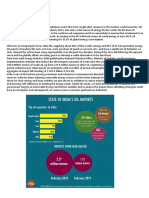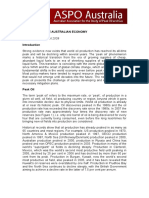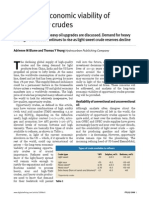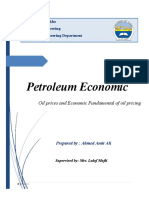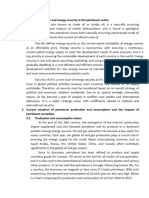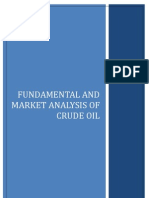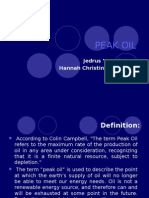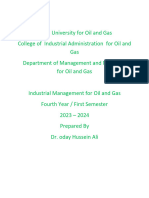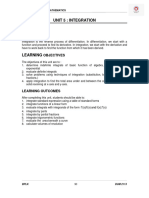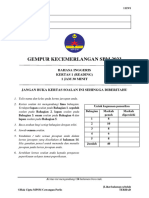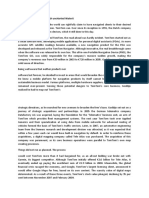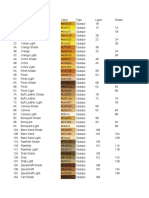Oil E-Course
Oil E-Course
Uploaded by
Vali BazdagaCopyright:
Available Formats
Oil E-Course
Oil E-Course
Uploaded by
Vali BazdagaCopyright
Available Formats
Share this document
Did you find this document useful?
Is this content inappropriate?
Copyright:
Available Formats
Oil E-Course
Oil E-Course
Uploaded by
Vali BazdagaCopyright:
Available Formats
OIL MODULE COURSE NOTES
WHERE IS OIL FOUND?
While petroleum is widely used, reserves of crude oil are spread unevenly around the world. Saudi
Arabia holds a fifth of the worlds oil and more than six times as much as the Asia-Pacific region.
Including Iran, Iraq, the United Arab Emirates, Kuwait and other producers, the Middle East holds
nearly 60% of the worlds proved reserves.
Reserves determine a countrys production potential, but production is influenced by other factors.
Saudi Arabia has by far the largest reserves and an estimated production capacity of 12.5
million barrels a day more than any other country could produce. However, it was not the
biggest producer in 2009, because it reduced its output, in line with Opecs production policy,
in order to support crude-oil prices during the recession. Iraq, with the third-largest oil
reserves in the world, did not even feature in the top-10 producer nations in 2008 war,
insurgency and prolonged underinvestment preventing it from realizing its potential. However,
it reached ninth position in 2009 and is expected to continue to climb the ranks over the next
few years. Venezuela, meanwhile, dropped out of the top-10 in 2009 because of persistent
underinvestment in its oil fields.
Worlds top-10 oil producers, 2009
Worlds top-10 oil producers, 2008
Million barrels a day
Country
Russia
Million barrels a day
Production
Country
10.032
Saudi Arabia
Production
10.846
Saudi Arabia
9.713
Russia
9.886
US
7.196
US
6.736
Iran
4.216
Iran
4.325
China
3.790
China
3.795
Canada
3.212
Canada
3.238
Mexico
2.979
Mexico
3.157
UAE
2.599
UAE
2.980
Iraq
2.482
Kuwait
2.784
Kuwait
2.481
Venezuela
2.566
Source: BP
Source: BP
OIL MODULE COURSE NOTES
OILS PLACE IN THE ENERGY MIX
Oil accounts for a third of the primary energy the world uses. Oil is used for heating, power generation and
as a feedstock for petrochemicals production. But transportation is the main driver of oil demand growth.
World primary energy demand
Oil: 34.1%
Gas: 20.9%
Coal: 26.5%
Nuclear: 5.9%
Other Renewables: 0.6%
Hydro: 2.2%
Biomass & Waste: 10%
Source: IEA
Oil demand growth may be dampened by a combination of the following factors:
Improvements in energy efficiency
Advances in engine technology
Biofuels
Electric vehicles
Synthetic transportation fuels produced from natural gas and coal
Government efforts to reduce oil usage by making it more expensive to produce carbon
However, no substitute is yet ready to replace oil at scale, and nothing can yet match it for economic
value or for energy density. As a result, oil will still be supplying a similar proportion perhaps 25%
by 2035 even if ambitious environmental policies are put in place.
In addition, because overall energy demand will increase in parallel with the expanding population
(see box), the world will continue to consume large volumes of oil for decades. The International
Energy Agency (IEA) estimates that oil demand will amount to between 81 million barrels a day and
107.4 million barrels a day in 2035, compared with the present level of about 87 million barrels a day.
2
OIL MODULE COURSE NOTES
The worlds population has roughly doubled in the past 50 years to 6.8 billion and its expected to
reach 9 billion or more by 2050 a lot more people wanting heat, light and mobility. In addition, in
China and India alone, more than 500 million people will move from a rural to an urban way of life
in the next two decades, leading to an increase in per capita energy consumption.
Forecasting oil demand
Oil demand will grow over the next two decades. Most, if not all of the growth in oil demand, is
expected to come from developing nations, such as China and India; oil demand in the rich countries
of the Organisation for Economic Co-operation and Development (OECD) has probably peaked.
But there is considerable uncertainty about the rate of growth. The IEA, for example, forecasts
demand will amount to between 81 million and 107.4 million barrels a day by 2035; the final
outcome will depend on economic growth, and the success governments have in introducing lowcarbon energy sources, such as biofuels, renewables and nuclear power, and energy-efficiency
policies. However, it is unlikely demand would ever reach the top end. It would be environmentally
undesirable because of its high carbon impact, and would be technically difficult to achieve.
In the IEAs New Policies Scenario, which takes account of broad policy commitments and plans
already announced by countries around the world, oil demand (excluding biofuels) will reach 99
million barrels a day by 2035 15 million barrels a day higher than in 2009. All of the growth will
come from developing countries, with 57% from China alone, mainly because of rising use of
transport fuels. Biofuels will reduce the need for oil for transportation, but only slightly.
OILS PLACE IN THE WORLD ECONOMY
Oil consumption and economic strength are inextricably linked. The biggest oil consumer in the
world, the US, is also the worlds biggest economy. The countries with the smallest per capita oil
consumption are typically the poorest. When the worlds oil supply threatens to become scarcer, its
importance quickly becomes evident (see box).
The links between energy and many other aspects of the economy mean oil prices also have a
significant effect on inflation. The price of oil dictates the cost of other forms of energy including
natural gas and the prices of manufactured goods, which need energy to be made, as well as
transportation and services.
OIL MODULE COURSE NOTES
In 2011, unrest in the Middle East affecting the production of Libya, an important oil producer
resulted in rapid oil-price inflation. In 2008, oil futures reached almost $150 a barrel, partly as
a result of escalating tension between the US and Iran over the latters nuclear programme,
which gave rise to concerns that Iranian oil sales could be disrupted.
Those events are part of a longer trend. In 1973, Middle Eastern oil producers suspended
exports to the countries that supported Israel in the Yom-Kippur War; this prompted a
fourfold rise in oil prices and sent the world economy into decline. Similarly, in 1979, the Iranian
Revolution led to a drastic drop in exports and a rapid escalation in world oil prices.
WHAT MOVES THE OIL PRICE?
High prices, in theory, result from a shortage of spare capacity. If supply is struggling to keep
ahead of demand, even relatively small disruptions to supplies or fears of disruptions can
result in higher prices. In the short term, oil demand is inelastic unable to adjust itself quickly to
fluctuations in oil prices. Interruptions could be caused by variety of factors, including oil-producing
facilities being temporarily closed down for maintenance, sabotage or bad weather.
Conversely, if there is too much spare capacity and the oil system can easily cope with demand, prices fall.
Prices ultimately dictate future supply. Low prices result in less investment, which causes supply
growth to slow down and eventually for the balance between supply and demand to tighten,
pushing up prices again. High prices, meanwhile, stimulate investment, which can lead to excess
supply and an eventual slump in prices.
Other factors affect oil prices. Opec argued that the oil-price spike that occurred in mid-2008 was
largely the result of speculation in financial markets. Although it is difficult to prove, the theory is
compelling and has become widely accepted: with China and India consuming spare oil to fuel the
rapid expansion of their economies, some investors thought oil prices would rise indefinitely; they
bought oil futures in order to sell them later at a profit, driving up oil prices in the process and
creating a self-fulfilling prophesy.
In addition, oil prices often rise when the US dollar falls and fall when the dollar strengthens. This
happens because a rise in the US dollar on currency markets makes oil more expensive to buy with
other currencies; also, buying oil securities has come to be regarded by banks, hedge funds and
other investors as a hedge against the falling dollar.
Measuring oil: the barrel.
OIL MODULE COURSE NOTES
CRUDE-OIL COMPOSITION
Crude oil is mainly made up of chains of carbon and hydrogen atoms, called hydrocarbons; it also
contains small amounts of sulphur, nitrogen, oxygen, metals and salts.
In order to become useful, crude oil must be refined into oil products, using a combination of heat,
pressure and catalysts.
Oils chemical flexibility enables refiners to turn undesirable hydrocarbon combinations into valuable
ones. The hydrocarbon compound is the most versatile on the chemical charts it is able to make an
estimated 2.5 million combinations.
TRANSPORTING OIL TO MARKET
At some point on its way to market, oil must pass through a pipeline to go from the point of
production to a consumption centre or to a coastal export point for onward transport by ship.
Oil can be transported by pipeline, rail and truck, but most internationally traded crude oil is
transported by sea.
Tankers are classified according to their
carrying capacity and usually have several
separate cargo tanks, enabling them
to carry different grades at the same
time. Transport costs fluctuate widely,
depending on oil supply and demand, and
the time of the year, as well as available
shipping capacity. Shorter-range product
tankers also transport refined petroleum
products by sea.
OIL MODULE COURSE NOTES
Oil tanker classifications
The carrying capacity of tankers is measured in deadweight tonnes (DWT) the weight of a
ships cargo, fuel, stores, passengers and crew, minus the weight of the ship itself.
The biggest tankers are called Ultra Large Crude Carriers, which can carry between 320,000
and 550,000 dwt. They are used for carrying crude oil on long-haul routes from the Persian
Gulf to Europe, the US and east Asia, via the Cape of Good Hope or the Strait of Malacca.
However, ULCCs are less common than Very Large Crude Carriers (VLCCs), which have a
capacity of between 150,000 and 320,000 dwt. Other categories include: Medium Range,
Panamax (the maximum size of vessel that can pass through the Panama Canal), Aframax,
and Suezmax (the biggest the Suez Canal can accommodate).
GRADES OF OIL
Oil varies in quality. Crudes are classified by density, sulphur content and various other
measurements established in an analysis called a crude-oil assay.
Lighter, or less dense, crude oils generally contain a greater proportion of higher-value products,
such as gasoline which can be recovered with simple distillation.
When simple distillation is applied to heavier, or denser, crudes, they tend to yield a greater share of
lower-value products, such as fuel oil. They generally require additional processing to produce the
desired range of products.
A grade or type of oil that yields a greater volume of high-value products is usually more
expensive than one that yields greater quantities of lower-value products.
The value of a particular crude oil is usually expressed as a premium or discount to a single
representative crude oil, a benchmark grade and reflects the degree of refining that it requires.
Grades are gauged by their specific gravity, according to a scale, calibrated in degrees, developed by
the American Petroleum Institute (API). Most values fall between 10 and 70API gravity. The heavier
the oil, the lower the gravity rating; the lighter the oil, the higher the gravity rating (see graphic).
OIL MODULE COURSE NOTES
Oil containing high levels of sulphur is known as sour crude. Crude with low levels of sulphur
is sweet crude. The sourer a crude, the more processing it requires and the less valuable it
tends to be.
West Texas Intermediate, the US benchmark, is a premium crude grade. It has a relatively
high natural yield of naphtha and gasoline, both of which are desirable, high-value products.
Nigerias Bonny Light, another premium grade, has a high natural yield of middle distillates.
However, almost half of the simple distillation yield from Saudi Arabias Arabian Light is a heavy
residue that requires further processing.
REFINING
Refineries come in many different sizes and configurations, depending on the size of the local
market, the types of products needed and the types of feedstocks available for processing.
But they all perform the same basic tasks; distilling crude oil into its various constituent fractions;
chemically rearranging low-value configurations of hydorcarbons molecules into high-value
combinations to produce a variety of end-products, from hydrocarbon gasoline to Tupperware; and
treating those products to meet environmental and other specifications and standards.
Hydrocarbons have a variety of uses, depending on their molecular structure.
For example, molecules used for cooking gas usually have up to four carbons, while gasoline is composed
of a longer chain, of up to 12. Lubricants motor oils, for example are even longer, with 50 carbons.
OIL MODULE COURSE NOTES
FRACTIONAL DISTILLATION
The components of petroleum have
different boiling points, so they can be
separated by heating the crude and
distilling the resulting vapour. First,
impurities such as water and salt are
removed from the crude. Then it is heated
often by burning fuel oil in a furnace.
The vaporised petroleum, heated to about
350C, is pumped into a fractionating
tower or atmospheric pipestill.
As the vapour rises up the tower, it cools down and its components condense back into several
distinct liquids, collecting in a series of trays.
The lightest products liquefied petroleum gas, naphtha and so-called straight-run gasoline are
recovered at the lowest temperatures, collecting near the top of the tower.
Middle distillates jet fuel, kerosene, diesel and home heating oil come next. These are followed
by the heaviest products, asphalt, lubricants and waxes. Heavy residue from the atmospheric
distillation process can also be reprocessed in a vacuum distillation unit, which uses a combination
of low pressure and high temperature to make more useful products.
At this stage of the refining process, jet fuel
is pretty much ready for use in an aircraft,
but most of the products arent finished.
They are blendstocks or feedstocks for
other processes. A combination of further
heating, pressure treatment and the use
of chemical catalysts break the chemical
bonds that link these chains together,
reconfiguring them into new combinations
to yield a host of desirable products.
A catalytic cracker can handle a number of feedstocks, including heavy gasoil, treated fuel oil and
residue from the lubricant treatment plant. Mixing the feedstock with a hot catalyst enables the
cracking reaction to take place at a relatively low temperature (about 500C). The products are
then separated in a fractionating column.
Another refining process, reforming, uses heat and pressure in the presence of catalysts to convert
naphtha feedstock into higher-octane, gasoline-blending components. The finished products
with marketable octane ratings and specific engine properties are then stored in tanks on the
refinerys premises, before being loaded onto barges, ships and trucks, or into special pipelines for
transportation beyond the refinery gate to market. Sulphur and other unwanted compounds are
removed in a hydrotreater.
8
OIL MODULE COURSE NOTES
OIL PRODUCTS
Motor gasoline/petrol: Gasoline is a light hydrocarbon fraction used in internal-combustion
engines. It is distilled from crude oil at between 35C and 215C. It can include additives such
as oxygenates to reduce the amount of carbon monoxide created during combustion, as well
as octane enhancers. It can also be mixed with ethanol.
Distillate fuels: This category covers a wide range of products, including diesels for use
in car engines, light heating oil and heavy gas-oils, which can be used as a feedstock in
petrochemicals plants. Diesel oil is distilled at around 180-380C. Diesel has overtaken
gasoline in the European market: fuel consumption is lower, and the performance of diesel
cars is now close to that of gasoline engines.
Jet fuel: Large turbine and turbo jet commercial aeroplanes use kerosene, similar to diesel.
This jet fuel needs to satisfy a welter of strict international regulations and usually has a
freezing point of lower than -40C to cope with cold temperatures at high altitude. Aircraft
operated by piston engines run on a different fuel aviation gasoline (avgas). This has a high
octane rating and more closely resembles motor gasoline than diesel.
Still gas: Also known as refinery gas, this is a gas, or mixture of gases (methane, ethane and
ethylene, for example), produced as a by-product of upgrading heavy petroleum fractions to
more valuable, lighter products through distillation, cracking and other methods. It can be
used as a refinery fuel or petrochemicals feedstock.
Residual fuel oils: Sometimes known as heavy fuel oils, these are extracted from what is
left after the distillate oils and lighter hydrocarbons have been distilled in the refinery. They
include oils suitable for powering some types of ships, power plants and heating equipment, as
well as for use in various other industrial purposes.
Asphalt and road oil: Also known as bitumen in some regions, asphalt is best known as a roadsurfacing material. A sticky semi-solid, it can be found in naturally occurring deposits, but it
can also be derived from crude oil, by separation through fractional distillation, usually in a
vacuum. It can be made harder by reacting it with oxygen. Road oil is any heavy petroleum oil
used as a surface treatment on roads.
Liquefied refinery gas: This is fractionated from refinery or still gases and kept liquid through
compression and/or refrigeration. These gases can include ethane, propane, butane, isobutane
and their various derivatives.
Petroleum coke: A black solid residue used as a feedstock in coke ovens for the steel industry,
for heating, chemicals production and for other purposes. It has high carbon content around
90-95% and low ash content, so it burns well. However, it has a high sulphur content, which
can create environmental problems. It is obtained by cracking and carbonising petroleumderived feedstocks, vacuum bottoms (the heavier material produced in vacuum distillation),
tar and pitches using processes such as delayed coking and fluid coking.
Liquefied petroleum gas (LPG): LPG is a type of refinery gas, mainly comprising propane. LPG
can be used to run vehicles and for domestic cooking and heating in remote areas that lack
alternative fuel sources. Or, indeed, firing up your barbecue.
9
OIL MODULE COURSE NOTES
Octane rating
This measures the resistance of fuels such as gasoline to detonation (or knocking) in an
engine. The rating is derived from comparisons between a given fuel and a benchmark mixture
of iso-octane and heptane. Higher octane ratings are more suitable for higher-performance
engines, whose greater compression ratios make the gasoline used more likely to detonate.
Gasoline engines work on 95- or 98-octane gasoline.
REFINERY ECONOMICS
Refining is a cyclical business. Gross margins the value of the products exiting the refinery minus
the cost of the crude oil reflect the sectors health. In recent years the refining business has spent
more time in weak parts of the cycle than strong ones, squeezed by rising operating costs and the
need for additional investment to meet higher environmental standards. Aided by sophisticated
computer software, refiners aim to run the optimal mix or slate of crudes through their refineries.
A refinerys profitability depends on:
The type and cost of the crude purchased
The prevailing price of individual oil products
The cost of the process that is selected to process the feedstock
The availability of facilities and technology capable of producing in-demand products
New flows of crude
Oil from unconventional sources, such as oil sands and oil
shale, is becoming more common.
These feedstocks require different refining techniques
from those used to process conventional crude oil, adding
another layer of cost.
For example, Canadas
oil sands produce
bitumen, which must
first be upgraded
in special units into
synthetic oil before
it can be refined
(synthetic crude oil
is called synthetic
10
OIL MODULE COURSE NOTES
because it is altered from its naturally occurring state by a chemical process.) The synthetic
crude oil can be upgraded using refinery processes such as distillation, coking, catalytic
cracking and hydroprocessing into a light sweet crude that can be converted into useful
petroleum products in a conventional refinery.
DOWNSTREAM: MARKETING AND DISTRIBUTION
Significant infrastructure in the form of roads, ships and products pipelines is required to move end
products from the refinery gate to end consumers.
Before being delivered to the customer, however, they are stored in petroleum products depots,
intermediary storage centres responsible for supplying a region, from which large volumes of
gasoline, diesel and heating oil can be dispensed locally as required.
Road tankers collect fuels heating oil, gasoline, diesel and aviation fuel from these depots,
delivering them to filling stations, businesses, homes and airlines.
The price of products to end-users are determined by a combination of the crude oil price, industry
margin and government taxes.
11
OIL MODULE COURSE NOTES
Storage
Crude oil is not always processed as soon as it arrives at its destination.
Many countries, especially in the developed world, hold strategic stocks of crude oil in
depleted reservoirs, above-ground tanks and tanker ships and products that allow them to
cope with any unexpected shortages of oil.
The level of oil stocks held in different locations around the world (but especially in big
markets such as the US and Europe) is an important determinant in the oil price because
stored oil serves as a buffer against supply shocks. The higher the stock level, the less the
market worries about supply interruptions. The lower the stock level, the more volatile prices
tend to become.
Mostly, governments mandate companies to hold minimum volumes of petroleum. Some
including the US, China and Japan have government-administered emergency oil stocks.
The US Strategic Petroleum Reserve (SPR), maintained by the Department of Energy, is the
worlds biggest, with a capacity of up to 727 million barrels.
IEA countries must hold oil-stock equivalent to 90 days of the previous years net imports.
PETROCHEMICALS
More value can be extracted from hydrocarbons by treating petroleum feedstocks in petrochemicals
plants to create new products.
The feedstocks the main ones being naphtha,
diesel and butane are treated in steam crackers,
which are usually located in the same place as a
refinery. The aim is to break down the molecules
under the action of heat to obtain substances
such as olefins (a group that includes ethylene
and propylene) and aromatics (distinctive smelling
chemicals like benzene and toluene).
12
OIL MODULE COURSE NOTES
These in turn provide the foundations for a range of familiar materials, including polyester, vinyl
acetate, polystyrene, polyurethane, detergent alcohols, synthetic rubber and many more products.
Petrochemicals production facilities are expensive to build, maintain and run. Like refiners, they
must contend with volatility in the prices of the commodities they produce, planning in years when
profits are high for times when margins are low.
13
OIL MODULE COURSE NOTES
BIOFUELS
Biofuels are a growing part of the fuel mix. These can be blended with, or even used instead of,
conventional gasoline and diesel.
Many governments, including the EU and the US, have mandated that biofuels account for a minimum
percentage of the fuel mix, so oil companies have become adept at acquiring and handling them.
The main biofuels on the market today so-called first-generation biofuels are:
Bioethanol
Biodiesel
They are made from a variety of raw materials, but are generally derived from crops such as:
Maize (bioethanol)
Sugar cane (bioethanol)
Palm oil (biodiesel)
Rapeseed (biodiesel)
Limits on biofuels market penetration
There are doubts over whether first-generation biofuels make a positive contribution to
the environment. In some cases, CO2 savings made by burning biofuels in motor vehicles can
be outweighed by the CO2 emitted during the cultivation of the crops, their conversion into
fuels and transportation to market. Ethanol has been successful in Brazil, where gasoline
has a 25% ethanol blend, but the country has the right climate and enough land to grow large
amounts of sugar cane. Few other countries share those natural advantages.
The US, for example, the worlds biggest ethanol producer, uses maize (corn) to produce
ethanol, but this is eight times less efficient as a biofuel crop than sugar cane. Ethanol
also has a lower energy density than gasoline about a third less. Biodiesel compares
more favourably to conventional refinery diesel in terms of energy content, but its a living
fuel; store it under the wrong conditions and it will go rancid. That adds another layer of
complication and cost. Ethanol or biodiesel tend to cause starting problems in cold weather,
too. And ethanol is corrosive, making it hard to transport.
In addition, land used for growing crops for fuels is land that cant be used for growing
crops for food; so biofuels cultivation presents a threat to food production and may cause
inflation in food prices.
Theres hope that second-generation biofuels, such as those produced from algae or biomass,
will help mitigate these problems by harnessing crops that grow on land that wouldnt be
suitable for food crops and by converting non-edible parts of plants into energy. But it will be
many years before these nascent technologies begin to have a big impact on fuel supply.
14
You might also like
- Porters Five Force On U.A.EDocument15 pagesPorters Five Force On U.A.ESai Vasudevan50% (2)
- By Dr.B.S.Koushika.,B.A.M.S, M.D (Ayu) Dept of Panchakarma, SJSACH, ChennaiDocument55 pagesBy Dr.B.S.Koushika.,B.A.M.S, M.D (Ayu) Dept of Panchakarma, SJSACH, ChennaiAyurvriksha100% (5)
- Crude Oil Market & Factors Impacting PricesDocument7 pagesCrude Oil Market & Factors Impacting PricesrohitNo ratings yet
- Political FactorsDocument8 pagesPolitical Factorsgoldensparrow88No ratings yet
- R.Lakshmi Anvitha (1226213102) : Green TechnologiesDocument8 pagesR.Lakshmi Anvitha (1226213102) : Green TechnologiesTejeesh Chandra PonnagantiNo ratings yet
- Oil CrisisDocument26 pagesOil CrisisSagar MojidraNo ratings yet
- Oil Price Surge and Quest For Energy: Sri Lanka in Global PerspectiveDocument7 pagesOil Price Surge and Quest For Energy: Sri Lanka in Global PerspectiveHasith DharmarathnaNo ratings yet
- Econometric Models For Oil PriceDocument16 pagesEconometric Models For Oil PricedanonninoNo ratings yet
- Team - Mud Men: Past Events Regarding ConflictDocument2 pagesTeam - Mud Men: Past Events Regarding ConflictsourravNo ratings yet
- Project Manisha StatDocument29 pagesProject Manisha StatShubham SainiNo ratings yet
- Research Paper - Oil Crisis in The 21ST CenturyDocument6 pagesResearch Paper - Oil Crisis in The 21ST CenturyAdil VasudevaNo ratings yet
- Understanding Shocks of Oil Prices: IJASCSE Vol 1 Issue 1 2012Document7 pagesUnderstanding Shocks of Oil Prices: IJASCSE Vol 1 Issue 1 2012IJASCSENo ratings yet
- Academic Research Essay On Oil Prices: Prakhar GuptaDocument13 pagesAcademic Research Essay On Oil Prices: Prakhar GuptaPrakhar GuptaNo ratings yet
- Gasoline Prices PrimerDocument17 pagesGasoline Prices PrimerEnergy Tomorrow50% (2)
- OPEC Oil Outlook 2030Document22 pagesOPEC Oil Outlook 2030Bruno Dias da CostaNo ratings yet
- Reuters Analysis 2014 Oil CrashDocument19 pagesReuters Analysis 2014 Oil Crashjohn smith100% (1)
- Task 2 - ImplementationDocument6 pagesTask 2 - ImplementationIndianagrofarmsNo ratings yet
- Ramady M Mahdi W Opec in A Shale Oil World Where To Next PDFDocument293 pagesRamady M Mahdi W Opec in A Shale Oil World Where To Next PDFBalanuța IanaNo ratings yet
- CS - OPEC CartelDocument4 pagesCS - OPEC Cartelroshansv23No ratings yet
- BP Peak Oil Demand and Long Run Oil PricesDocument20 pagesBP Peak Oil Demand and Long Run Oil PricesKokil JainNo ratings yet
- Iv. Oil Price Developments: Drivers, Economic Consequences and Policy ResponsesDocument29 pagesIv. Oil Price Developments: Drivers, Economic Consequences and Policy Responsesdonghao66No ratings yet
- Appendix Peak Oil & Australian EconomyDocument17 pagesAppendix Peak Oil & Australian Economykirubha_karan2000No ratings yet
- Heavy Crude Processing 808157080Document7 pagesHeavy Crude Processing 808157080kapurrrn100% (2)
- Integrated Comprehensive Study To Design Optimum Appropriate Economic Enhanced Oil Recovery Technique. A Real Case Study in Surma BasinDocument6 pagesIntegrated Comprehensive Study To Design Optimum Appropriate Economic Enhanced Oil Recovery Technique. A Real Case Study in Surma BasinMuntasir RadNo ratings yet
- Energy Outlook 2014Document6 pagesEnergy Outlook 2014Esdras DemoroNo ratings yet
- Peak Oil - WDocument26 pagesPeak Oil - Wvincent brazilNo ratings yet
- Case SummaryDocument6 pagesCase SummaryMohamed IbrahimNo ratings yet
- Examine The Claim That The World Is Too Dependent On OilDocument28 pagesExamine The Claim That The World Is Too Dependent On OilSaad MemonNo ratings yet
- Petroleum Economic: Oil Prices and Economic Fundamental of Oil PricingDocument12 pagesPetroleum Economic: Oil Prices and Economic Fundamental of Oil PricingAhmed AmirNo ratings yet
- Crude Oil Price Trends in Global MarketDocument28 pagesCrude Oil Price Trends in Global MarketRITESH MADRECHA100% (1)
- Demand of Petrolium ProductDocument18 pagesDemand of Petrolium ProductSwapnil MurudkarNo ratings yet
- Energy Security in The Petroleum SectorDocument4 pagesEnergy Security in The Petroleum SectorhoangvinhhpvnNo ratings yet
- E&P-Industry Analysis PaperDocument9 pagesE&P-Industry Analysis Paper10manbearpig01No ratings yet
- Report - 53915778 - Oil Politics and CurrencyDocument13 pagesReport - 53915778 - Oil Politics and CurrencyKavONo ratings yet
- Oil Price FluctuationDocument28 pagesOil Price FluctuationmksscribdNo ratings yet
- Demand and Supply Crude OilDocument25 pagesDemand and Supply Crude OilRohan R TamhaneNo ratings yet
- 01 Changes Supply Demand Crude OilDocument14 pages01 Changes Supply Demand Crude Oilkaustubh_dec17No ratings yet
- Price Dynamics of Crude OilDocument3 pagesPrice Dynamics of Crude OilnitroglyssNo ratings yet
- Shale Oil and EffectsDocument20 pagesShale Oil and EffectsDag AlpNo ratings yet
- Fundamental Analysis Final 2Document22 pagesFundamental Analysis Final 2Supriya Rai GoyalNo ratings yet
- Supply and Demand of Tanker MarketDocument21 pagesSupply and Demand of Tanker MarketHamad Bakar Hamad100% (1)
- India'S International Movement To Unite Nations: Page 1 of 16Document16 pagesIndia'S International Movement To Unite Nations: Page 1 of 16Nachiketh ReddyNo ratings yet
- The U.S. Shale Oil Boom, The Oil Export Ban, and The Economy: A General Equilibrium AnalysisDocument61 pagesThe U.S. Shale Oil Boom, The Oil Export Ban, and The Economy: A General Equilibrium Analysisag rNo ratings yet
- Oil Pricing IntroDocument3 pagesOil Pricing IntrofrozenberryNo ratings yet
- GenesisDocument12 pagesGenesisGaurav SinghNo ratings yet
- ADL BaseOilDocument4 pagesADL BaseOilhazmijemiNo ratings yet
- Mba Project On OpecDocument65 pagesMba Project On Opecmukesh_saroj0070% (1)
- Ecbwp1855 en PDFDocument34 pagesEcbwp1855 en PDFAmrNo ratings yet
- Yousif Al Ateeqi - 207116632: Petrolium Assignment 3/11/2010Document4 pagesYousif Al Ateeqi - 207116632: Petrolium Assignment 3/11/2010Yousif Al AteeqiNo ratings yet
- History and MembershipDocument6 pagesHistory and Membershipt a khanNo ratings yet
- Petroleum Engineering Course Name: Malak Ahmad Abu Radaha REG - Number:31715019045Document4 pagesPetroleum Engineering Course Name: Malak Ahmad Abu Radaha REG - Number:31715019045Malak Abu RadahaNo ratings yet
- CompositionDocument22 pagesCompositionPadma BhushanNo ratings yet
- OPEC - Umesh Sharma - Case StudyDocument3 pagesOPEC - Umesh Sharma - Case StudyNaman AryanNo ratings yet
- Oil Glut and The New EquationDocument4 pagesOil Glut and The New EquationRothindra Nath GoswamiNo ratings yet
- The U.S. Tight Oil Boom: Geopolitical Winner or Long-Term Distraction?Document11 pagesThe U.S. Tight Oil Boom: Geopolitical Winner or Long-Term Distraction?The American Security ProjectNo ratings yet
- Peak OilDocument18 pagesPeak Oilapi-3706215No ratings yet
- Cause and Effect - US Gasoline Prices 2013Document7 pagesCause and Effect - US Gasoline Prices 2013The American Security ProjectNo ratings yet
- Wa0003.Document10 pagesWa0003.mohamedkk730No ratings yet
- Energy Myths and Realities: Bringing Science to the Energy Policy DebateFrom EverandEnergy Myths and Realities: Bringing Science to the Energy Policy DebateRating: 4 out of 5 stars4/5 (5)
- An Introduction to Petroleum Technology, Economics, and PoliticsFrom EverandAn Introduction to Petroleum Technology, Economics, and PoliticsNo ratings yet
- Torque - Chart: Larger Diameter Tool Joints Recommended Make-Up Torque (FT-LBS.)Document1 pageTorque - Chart: Larger Diameter Tool Joints Recommended Make-Up Torque (FT-LBS.)Vali BazdagaNo ratings yet
- POMPA PZL 1600 HP Triplex PDFDocument2 pagesPOMPA PZL 1600 HP Triplex PDFVali Bazdaga0% (1)
- Revised GP-7033 Handbook - CoverDocument116 pagesRevised GP-7033 Handbook - CoverVali BazdagaNo ratings yet
- Make Up Torque Chart BesteDocument1 pageMake Up Torque Chart BesteVali Bazdaga100% (1)
- WEEK3 Dev. The Whole PersonDocument33 pagesWEEK3 Dev. The Whole PersonJitz BugoyNo ratings yet
- Bushing Monitoring SystemDocument140 pagesBushing Monitoring SystemJitendra Singh100% (1)
- Sweep Function Generator Model B - 810Document26 pagesSweep Function Generator Model B - 810EduardoFonsecaNo ratings yet
- ch5 Phy PDFDocument39 pagesch5 Phy PDFStar Packs Print SolutionNo ratings yet
- Group 1: Madhya Kailash: UrbanDocument10 pagesGroup 1: Madhya Kailash: Urbanraja vijjayNo ratings yet
- Brkarc 2003Document31 pagesBrkarc 2003Praveen RaiNo ratings yet
- Adhi Concrete Pavement System (Acps) Untuk AirportDocument22 pagesAdhi Concrete Pavement System (Acps) Untuk AirportStenly WanmresNo ratings yet
- LCT RT4000 ServiceDocument41 pagesLCT RT4000 ServicePhillip CampbellNo ratings yet
- Cycloalkane - Bayer Strain Theory and Limitation of Bayer Strain TheoryDocument5 pagesCycloalkane - Bayer Strain Theory and Limitation of Bayer Strain TheorySayed AltamashNo ratings yet
- Document 10Document5 pagesDocument 10AB AUTO GalleryNo ratings yet
- Unit 4 IntegrationDocument34 pagesUnit 4 Integration[T3A] Siti najihah mansorNo ratings yet
- Positioning Patients in BedDocument27 pagesPositioning Patients in BedAldo BGamanNo ratings yet
- Gambaran Penatalaksanaan Penyakit Deabetes Melitus Dipoli Penyakit Dalam Rsud Pariaman Agustika AntoniDocument8 pagesGambaran Penatalaksanaan Penyakit Deabetes Melitus Dipoli Penyakit Dalam Rsud Pariaman Agustika AntoniAlif Akbar HasyimiNo ratings yet
- Gempur Kecemerlangan SPM 2023: Bahasa Inggeris Kertas 1 (Reading) 1 Jam 30 MinitDocument13 pagesGempur Kecemerlangan SPM 2023: Bahasa Inggeris Kertas 1 (Reading) 1 Jam 30 Minitjane gréyNo ratings yet
- Jaguar Land RoverDocument11 pagesJaguar Land RoverAadhi ShankarNo ratings yet
- Agilent 5530 Dynamic Calibrator - Update InformationDocument11 pagesAgilent 5530 Dynamic Calibrator - Update Informationcmm5477No ratings yet
- APCalAB - PT01 - Section1 - Part BDocument10 pagesAPCalAB - PT01 - Section1 - Part BSurgaltiin Alba MBparkNo ratings yet
- The Definition of Fever - The BMJ PDFDocument2 pagesThe Definition of Fever - The BMJ PDFZACHARIAH MANKIRNo ratings yet
- ProfileDocument5 pagesProfileSyed SamsamuddinNo ratings yet
- Plate Load TestDocument21 pagesPlate Load Tests shila devi100% (2)
- Tomtom: Navigating Through Uncharted WatersDocument2 pagesTomtom: Navigating Through Uncharted WatersvjNo ratings yet
- EIA of Building Construction Using RIAM Analysis Full Paper - IITGuw PDFDocument9 pagesEIA of Building Construction Using RIAM Analysis Full Paper - IITGuw PDFNicole Zyra GuzmanNo ratings yet
- Extensor Tendon InjuriesDocument18 pagesExtensor Tendon InjuriesaparnaNo ratings yet
- Wargames Foundry v0Document26 pagesWargames Foundry v0fake nameNo ratings yet
- 07-Chapter 7 Interface ModulesDocument8 pages07-Chapter 7 Interface ModulesBakyt MataevNo ratings yet
- Grade VIII ICT Final Java Sample PaperDocument5 pagesGrade VIII ICT Final Java Sample PaperaanyabothraNo ratings yet
- Las MeninasDocument3 pagesLas MeninasSupriya ChoudharyNo ratings yet
- Volvo Trucks Mid128 Engine Control Unit Fault CodesDocument1 pageVolvo Trucks Mid128 Engine Control Unit Fault Codeschristian100% (57)
- Gulshan Kumar Project FileDocument7 pagesGulshan Kumar Project FileShubhamNo ratings yet


